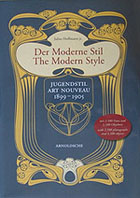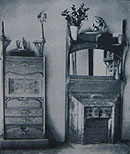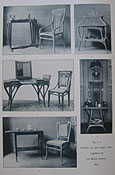The browser will either open the file, download it, or display a dialog.
|
Julius Hoffmann, ed. |
||||||||||
| Between 1899 and 1905, publisher Julius Hoffmann, Jr. actively promoted continental Art Nouveau to a German audience through editions of plates culled from specialized art periodicals. Known in Germany as Jugendstil, Art Nouveau was an international movement in architecture and design between 1890 and 1914 encompassing multiple idioms and diverging design philosophies across Europe. While the bulk of twentieth-century scholarship myopically addresses Art Nouveau as an elite, sinuous, and superficial art form, profound social consciousness united many of its exponents through their concern for housing and aesthetic democratization.1 In conjunction with Art Nouveau's centennial, scholars are beginning to uncover the complex local relationships and conditions affecting stylistic and ideological development. By contrast, Der Moderne Stil / The Modern Style: Jugendstil / Art Nouveau, 1899-1905, the 2006 re-edition of selections from Hoffmann's Der Moderne Stil, remains neutral regarding emerging scholarship, acting instead as a design encyclopedia. As advertised by the book's American distributor, Antique Collectors' Club, the luxurious edition targets an audience of "art historians, dealers, auctioneers and collectors alike." This audience may well be limited to such given its high cost. | |||||||||||
| Being a source book was also the essential function of Hoffmann's original collection. In total, Hoffmann published 84 volumes of illustrations comprising a comprehensive index of major as well as lesser known European decorative artists, 709 of which are featured in the re-edition. The weighty tome of 2500 images, however, represents only a selection (p. 16). Editor Horst Markus indicates that book-binding, interior decoration, wallpaper, and textiles were omitted in the reprint. This is somewhat problematic, if understandable, since Art Nouveau was an inherently holistic design approach in which all decorative elements were integral to a harmonious Gesamtkunstwerk. However, as Markus aptly notes, Hoffmann's focus was without question the individual object and artistic genius (p. 11). The categories included are furnishings, metal work, glass, ceramics, and jewelry, although these have also been edited for this volume. How selections were made remains unclear. In certain instances, individual plates have been rearranged but are delineated as such under the heading assemblages. The high-quality reproductions of photographs, drawings, and engravings constitute the re-edition's core value as a research tool. As indicated by Markus, the monochrome prints are of higher contrast than the color prints of the originals from contemporary journals (p. 15). Most source journals were French, including Art et décoration, Revue d'art, Revue des arts décoratifs, Documents sur l'art industriel, L'Art dans la vie, and Documents d'atelier. | |||||||||||
| The re-edition renders accessible these rare treasures, most of which pose significant conservation challenges and are housed in only a few, largely European, archives.2 The reprinting of fin-de-siècle journal source materials in Der Moderne Stil enables the reconstruction of nuanced positions regarding: national interest; the socio-political import of art; the creation of style; the broader cultural reception of Art Nouveau; the case for rationalism; and the relationship of the people to art. Fostered by 1881 legislation ensuring freedom of the press and the emergence of cheaper printing techniques, journals multiplied and specialized at the turn of the century. They constituted a means for movements, artistic and otherwise, to gain legitimacy and develop positions. Other source material includes publications such as Roger Marx's La Décoration et les industries d'art à l'Exposition Universelle de 1900 and the unspecified sales catalogues of manufacturers. | |||||||||||
| As is well reflected in this volume, myriad distinct Art Nouveau currents and individuals competed in the fin-de-siècle stylistic forum. One of the best known was entrepreneur Siegfried Bing, who opened the Maison de l'Art Nouveau in Paris in December 1895.3 He commissioned international artists to design holistic rooms in a promotional technique modeled on Picard's La Maison de la Toison d'Or, opened in Brussels in 1894. Bing's shop closed in 1904, victim of xenophobic criticism and financial insolubility. His contribution has been somewhat aggrandized due to the misconception, propagated by Bing himself and repeated by Markus, that it was Bing who first introduced the term Art Nouveau (p. 13).4 However, advocacy of a modern "art nouveau" was common parlance in French and Belgian artistic journals as early as 1887; the first isolated mention dated to 1871.5 Bing himself first used the phrase as early as 1888 to describe Japanese art.6 Use of the lower case long persisted as a symbol of the modern rationalist approach rather than the specific aesthetic of the curvilinear line. As outlined in Camille Lemonnier's 1897 article, "L'art nouveau," the movement prioritized insurgence against preconceived artistic dogma, infusion of the social into art, and ahistoricism.7 | |||||||||||
|
The subtitle of Hoffmann's original publication was "An international survey of the supreme achievements by artists working in commercial fields," notable in its implied emphasis on the accessibility of the designs. (p. 6). Amongst the artists maintaining Parisian shops were the Nancy School artists Louis Majorelle, Émile Gallé and the Daum brothers as well as Belgian designer Gustave Serrurier-Bovy. The social art advocate, German critic, entrepreneur, and L'Art décoratif editor Julius Meier-Graefe also marketed mass-produced designs by Abel Landry, Henry van de Velde, and Pierre and Tony Selmersheim at his La Maison moderne shop.8 Additional independent artists and creative consortiums included Frenchmen Hector Guimard, Rupert Carabin, Théodore Lambert, Groupe des Six members Félix Aubert and Charles Plumet, and Damon and Colin; the English C. F. A. Voysey, C. R. Ashbee and the Guild of Handicraft, Morris and Company, and A. W. Simpson; Charles Rennie Mackintosh and Margaret MacDonald Mackintosh of Scotland; Germans M. J. Gradl and Alfred Bühler; as well as representatives from Hungary, Sweden, Austria, Czechoslovakia, Holland, Belgium, Denmark, the United States, and Finland. It can be hoped that this reprint will peak interest in many artists who, while celebrated by their contemporaries, have remained understudied, notably Léon Benouville and Landry (figs. 1 and 2). An annotated index in German compiled by Markus contributes to the usability of the catalogue, although it provides only extremely limited biographical information (p. 450-463). | ||||||||||
|
Although Markus purposefully chose his approach to echo Hoffmann's original mission, in this scholar's opinion there is a lack of socio-cultural analysis of contemporary reception of Der Moderne Stil or of the style's sudden demise (p. 6). Markus provides a brief introduction in both German and English, wherein he makes little mention of the original publication's text, with the exception of what he cites as Hoffmann's stated purpose:
But did Hoffmann have either a financial or professional investment in positive German reception of Art Nouveau? Markus astutely discusses the role of the pattern book in regards to contemporary debates about historicism, as well as the centrality of Universal Exhibitions, both of which would have benefited from further development. The heavily French focus of Der Moderne Stil is another intriguing point of interest. How were international artists received in Germany, given that Art Nouveau developed in the atmosphere of increasing nationalism that preceded the First World War? Finally, what was the extent of Der Moderne Stil's circulation? Who constituted its readership? Additional information regarding the bias, mission, and prominence of each source journal would have also provided helpful context (p. 12). Art et décoration, for instance, was one of the most widely published art journals in France between 1897 and 1919, a distinction it shared with the Gazette des Beaux-Arts, which was not chosen by Hoffmann. |
|||||||||||
| Most problematic is the omission of any discussion regarding the appellation "Modern Style". Although he presents Hoffmann's title choice as a simplification or "elegant way of avoiding the terminological pitfalls", Markus does not account for subtleties amongst the multiplicity of contemporary terms used to characterize the style (p. 6). In fact, the particular term Modern Style raises some question as to which ideological aspects of the broader movement Hoffmann subscribed. The complication is of such import that it demands not only further analysis but necessitates biographical investigation regarding Hoffmann's role as a promoter. For instance, what was his professional relationship with fellow Germans and Art Nouveau dealers Bing and Meier-Graefe? | |||||||||||
| Many historians reduce Art Nouveau to a forced artificial attempt to invent a style divorced from tradition, a misleading assessment that more aptly characterizes what contemporaries differentiated, after 1900, as the debased modern style. All too cursorily Markus addresses the delicacy of Hoffmann's stance in the conflict between historicism and modernity (p. 7-8). While noting concessions to the tradition of models compendia, Markus asserts Art Nouveau's thirst for novelty, thereby missing an opportunity to situate Hoffmann more critically amidst the complexity of movement's evolution. Contemporary champions of a rational simplified Art Nouveau consistently decried commercial caricature while embracing industrialization: "It goes without saying that we again reject the misguided who think that they create Art Nouveau by rolling their decors in entanglements of transalpine noodles."9 In 1901, critic Charles Saunier deplored the largely Faubourg-Saint-Antoine-engineered Parisian Modern Style—the neighborhood renowned for cheap furniture workshops—to which he contrasted artistic domestic production.10 Meanwhile, hostile French critics perpetuated the conflation of terms as a means of decrying the perceived excesses and foreign origins of Art Nouveau.11 The Anglicized Modern Style, as distinguished from the generic descriptor style moderne, connoted the pervasive imitation and marketing of Art Nouveau by merchants capitalizing on a popular market eager to emulate bourgeois taste. Those seeking to discredit the movement largely opposed popularization and sought to preserve bourgeois hegemony in art.12 Their resentment increased in antagonism in the wake of the Universal Exhibition of 1900. The perceived extravagance, however, was largely a function of the Modern Style's flooding of the market share.13 The insult redirected longstanding French animosity towards all things English, ironically playing on the style's diffuse origins in Arts and Crafts, given that the English themselves largely disdained Art Nouveau as tasteless, artificial, and fleeting.14 This context becomes only more complex when exported to a German audience. What was German understanding of or position in this increasingly nationalistic debate? | |||||||||||
| By contrast, what connotations did the term Art Nouveau hold for its exponents? Most of the French artists represented in Der Moderne Stil can be characterized as Art Nouveau rather than Modern Style. If socially-minded Art Nouveau artists sought mass dissemination through industrial collaboration, why did its champions reject the successfully commercialized Modern Style? The distinction was that artists maintained that only their creative leadership could imbue industry with integrity. Modern Style production, on the other hand, was typically poor in quality and lacking in subtlety. Formally, Art Nouveau engendered the negation of the traditional division of the major and minor arts, abstracted natural motifs, prioritization of new materials, technology, and industry, and affronting the hygienic requirements and democratic ethos of modern life. By rendering the Der Moderne Stil visual catalogue once again accessible, this re-edition makes a valuable contribution to ongoing reassessment and exploration of these questions. | |||||||||||
| Astrid M. B. Liverman, Ph.D. Architectural Historian with the Historic Preservation Division of the State of Hawai'i astrid.liverman[at]gmail.com |
|||||||||||
|
1. Astrid Liverman, Art Nouveau as Social Art: The Modern Democratic Aesthetic of Parisian Worker Housing 1894-1914, Ph.D. Dissertation (Charlottesville: University of Virginia, 2006). 2.According to OCLC Worldcat, the following archives hold selected volumes of Der Moderne Stil: New York Public Library Reserves; National Taiwan University; University of Southern California; Smithsonian Institution; Louisiana State University; Pratt Institute; University of Oklahoma; Drexel University; California State Library; National Gallery of Art; Northwestern University; University of Minnesota Minneapolis; Juliette K. and Leonard S. Rakow Reserve Library; University of the Arts; and Bibliotheek van de Universiteit van Amsterdam. 3. Art historian Gabriel P. Weisberg has published extensively on Bing: "Samuel Bing: patron of art nouveau. Part I: The Appreciation of Japanese Art," The Connoisseur 172.692 (Oct 1969), 119-125; "Samuel Bing: patron of art nouveau. Part 2: Bing's Salons of Art Nouveau," The Connoisseur 172 (1969), 294-299; Art Nouveau Bing: Paris Style 1900 (New York and Washington: Abrams and Smithsonian Institution Traveling Exhibition Service, 1986); "Siegfried Bing and Industry: The Hidden Side of L'Art Nouveau," Apollo: The International Magazine of the Arts (Nov 1988), 326-329; Weisberg, Edwin Becker, and Evelyne Possémé, eds., The Origins of L'Art Nouveau: The Bing Empire (Ithaca: Cornell University Press, 2005). 4. See S. Bing, "L'Art Nouveau," The Architectural Record 12.5 (Sep 1902), 279-285; Jean Schopfer, "L'Art Nouveau: An Argument and Defense," Trans. by Irene Sargent The Craftsman 4.4 (Jul 1903), 229-237; Debora L. Silverman, "The Brothers de Goncourts' Maison d'un Artiste: French Art Nouveau between History and the Psyche, 1869-1889," Arts Magazine 59.9 (May 1985), 120; Stephen Tschudi Madsen, Sources of Art Nouveau (New York: George Wittenborn, Inc., 1955), 81. 5. "L'Art jeune," L'Art moderne 4.10 (9 Mar 1884), 74. 6. Malcolm Haslam, In the Nouveau Style (Boston: Little, Brown and Company Inc., 1990), 19. 7. Camille Lemonnier, "L'art nouveau," L'Art moderne 7 (1887), 85. 8. G. M. Jacques [Julius Meier-Graefe], Yvanhoë Rambosson, and F. R. Aubry, Documents sur l'art industriel au vingtième siècle (Paris: Éditions de la Maison moderne, 1901). 9. M. Champimont, "Une autre philosophie du 'modern style,'" L'Art décoratif 82 (Jul 1905). 10. Charles Saunier, "L'ornement qui passe: Origines du mouvement actuel," La Plume 12.288 (15 Apr 1901), 234. 11. Jean-Louis Pascal, reporter for the jury of the 1904 Paris façade competition, distinguished the terms as separate, albeit related, in Les Concours de façades de la ville de Paris 1898-1905 (Paris: Librairie de la 'Construction moderne'), 20. See also Remy de Gourmont, "Sur l'Art Nouveau," Mercure de France ser. mod. 151.147 (Mar 1902), 699. "Le modern style—l'anglais des imbéciles n'est pas toujours aussi transparent—manqua de se discréditer par cette formule d'une anglomanie naïve (…) La vulgarisation avait été trop rapide, les architectes contaminés trop vite." See also Camille Mauclair, "La crise des arts décoratifs," Revue politique et littéraire: Revue bleue 5th ser.5.24 (16 June 1906), 755. "À un moment où l'on se répandait en discours sur la nécessité de créer un 'art nouveau' et un 'style moderne' (sans avoir besoin du barbarisme de 'modern-style,') afin d'arriver à un style de notre temps et de fuir l'imitation impuissant et excédante des styles d'antan, on pouvait espérer que l'entente cordiale et égalitaire des artistes et des artisans amènerait cette cohérence, ce parallélisme d'efforts, sans lesquels la constitution d'un style neuf ne pourrait s'accomplir." Finally, see Gustave Soulier, "Henri Sauvage," Art et décoration (Jan-Jun 1899), 74. "C'est l'étude de la construction qui tient dans ses meubles la place capitale; et c'est pourquoi M. Sauvage s'élève avec force contre les meubles anglais de 'modern style' que l'on s'efforce, à la faveur de la mode, de répandre chez nous et de nous faire prendre pour le type nécessaire du mobilier nouveau." 12. Mauclair, "La crise des arts décoratifs," 756. 13. Victor Champier, "Une salle à manger," Art et décoration 2 (1901), 337-343. 14. "L'Art nouveau : What it is and What is thought of it. A Symposium—III," The Magazine of Art n.s. 28 (1904), 325. See also C. F. A. Voysey, op. cit., in "L'Art Nouveau : What it is and What is thought of it. A Symposium—I," The Magazine of Art n.s. 28 (1904), 212. See also Walter Crane, "Modern Decorative Art at Turin: General Impressions," The Magazine of Art 26 (1902), 488-493. |
|||||||||||
|
|





